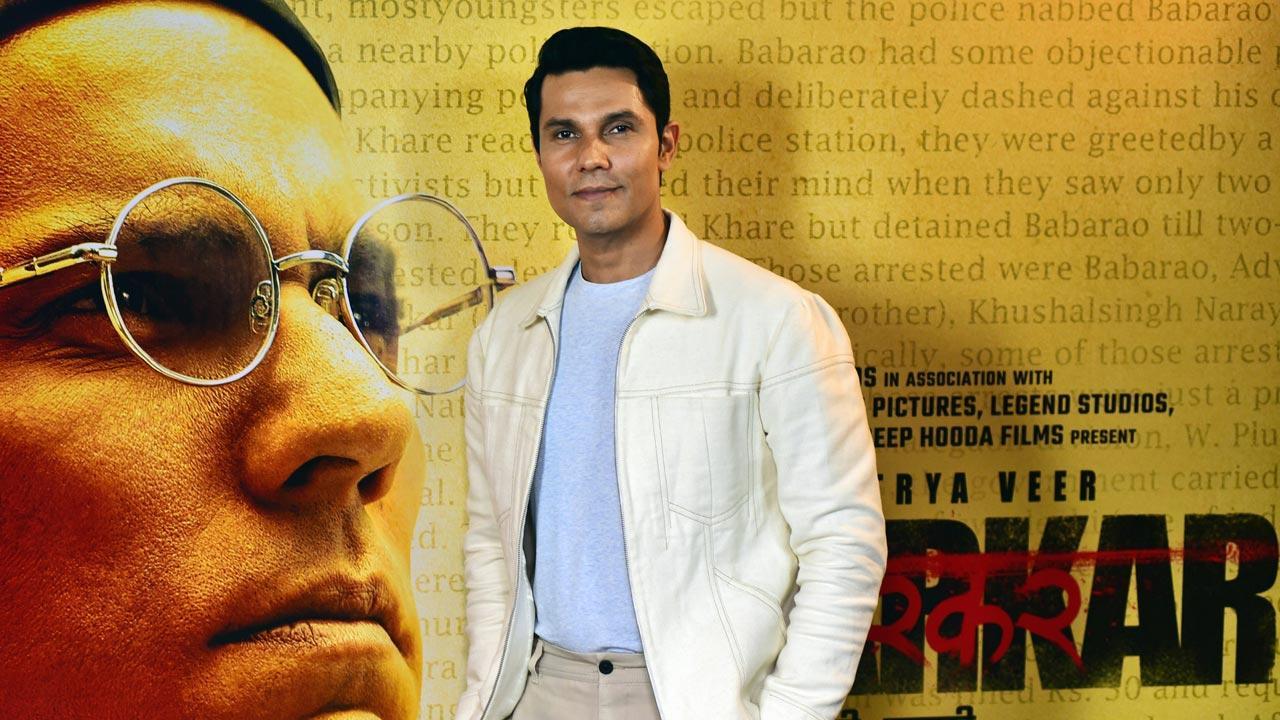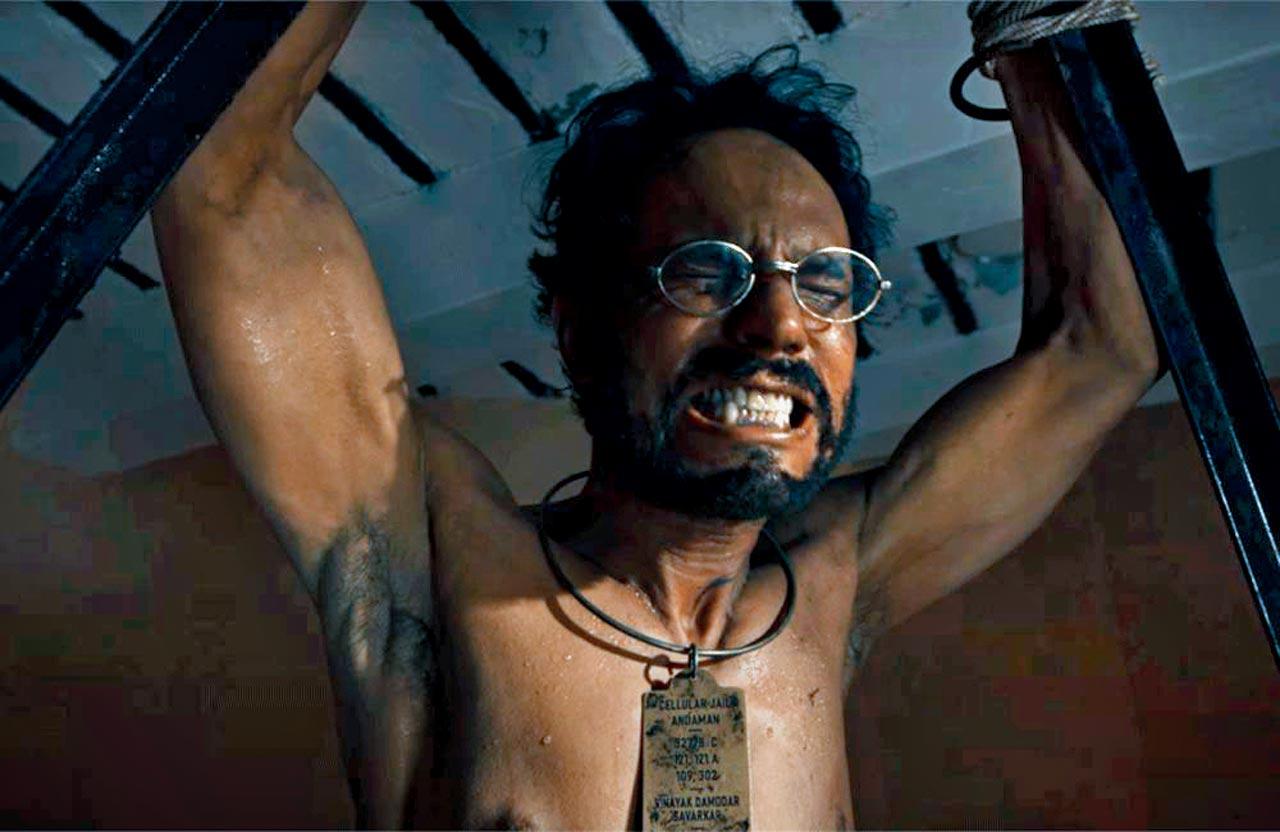Randeep Hooda plays Vinayak Damodar Savarkar in his directorial debut, and hopes the thriller will shed new light on the much-maligned nationalist

Pic/Nimesh Dave
If you thought Vinayak Damodar Savarkar and Mohandas Karamchand Gandhi were antagonists, given that the former was accused of playing a part in the latter’s assassination plot, actor Randeep Hooda will tell you differently. “They had completely different ways of going about it, but their end goal was the same: Akhand Bharat,” he says. “In fact, when Savarkar was in Kala Pani [Cellular Jail], it was Gandhiji who advised his brother, Narayanrao, about how to draft the bail plea.” It has been claimed that Savarkar swore allegiance to the British if he was released.
Hooda plays the controversial man in his directorial debut, Swatantra Veer Savarkar (due to release on March 22), and is now a veritable expert on his life, likes, dislikes, and ideologies. “But this movie is not a history lesson,” he laughs, “It’s supposed to be entertaining as well.” The “anti-propaganda film”, as he calls it, is a retelling of Savarkar’s life. The intellectual-writer developed the nationalist political ideology Hindutva in Ratnagiri in 1922, and was a leading figure in the Hindu Mahasabha. He was also sentenced to two life-terms at Kala Pani (after he was found guilty of supplying the pistol used to assassinate the then collector of Nasik, AMT Jackson, in 1909) and composed 6,000 poems when incarcerated. His book, The Indian War of Independence, about the first war for freedom in 1857, was banned before it came out.
 The movie, Swatantra Veer Savarkar, is as Hooda says, a “retelling” of the activist and writer’s life
The movie, Swatantra Veer Savarkar, is as Hooda says, a “retelling” of the activist and writer’s life
However, members of the Hindu Mahasabha turned against him when he distanced himself from Nathuram Godse and others accused of playing a part in Gandhi’s assassination plot during their trial. Though Godse had claimed full responsibility for the assassination, court approver Digambar Badge had said that Godse had a meeting with Savarkar before the assassination, where Savarkar told them all, “Yashasvi houn ya (be successful and return)”. He was branded a traitor and coward, and though the Bharatiya Janata Party has tried to rebrand him as “Veer”, the nasty names continue to follow him around. We meet Hooda in Juhu, and he is in good spirits, wanting to delve deep into Savarkar’s psyche.
Excerpts from an interview
What was your first introduction to Savarkar?
I think Kala Pani and Savarkar were synonymous for me when I was a child. When I started digging deep, I found there was so much missing from the public domain. I wondered why it has been swept under the carpet. My well-wishers told me, “Why are you getting into this? Why become political? You are an artiste”. I replied, “His story needs to be told, whatever it takes.” The kind of name-calling that happens in his name is unjustified. I just pursued the goal to correct that wrong with all sincerity. I ended up co-writing the film and directed it as well. It’s taken me two years of only thinking about Savarkar. I have put everything on the line—emotionally, monetarily, physically. And I’m so grateful people will know his special story.
What was the research involved?
I read books in English, Hindi; spoke to Maharashtrian filmmakers and historians who have written about him. I read about him and I read what he wrote. He is such a profound writer... People have just heard things through “WhatsApp university”, and keep calling him maafiveer (apologist). He was not that. He was just 26, and sentenced to serve two life terms. He went to Kala Pani in 1911 and the date of his release was 1960—he would have been 76! He used to keep writing bail pleas, but they were too flowery. Then Gandhiji asked him to keep it short, and that’s how he got out. Narayanrao was lynched after Gandhiji’s murder—8,000 Brahmins were lynched in Maharashtra. So much for non-violence. People don’t know about most of this.
He had a complicated relationship with Gandhi...
They had opposing ideologies, and both were very stubborn. They met three times—in 1907 at London’s India House; and once at a restaurant on Vijay Dashmi, and gave speeches together. Then in 1927, Gandhi visited him in Ratnagiri when he was placed under house arrest. They started at opposite ends, but met in the centre united by one purpose: A united India. But both of them were not part of the government, much like revolutionaries all over the world. Revolutionaries fight; politicians take control.
Was Savarkar less about religion, and more about nation?
Yes. Till 1920, everyone was one. In 1920, a caliphate movement started in Rae Bareli. Many Muslim leaders thought that India was a sultanate when the British came, and that it should go back to being a sultanate when they left. They didn’t want to be a part of the Congress’ democratic process, where they were a minority. To get them involved, Gandhiji became president of the Khilafat Movement, and there on began the process of appeasement. They were given more seats, and electorates.
This irked Savarkar. He came up with the Hindutva philosophy in response: he held that everyone who lived in the region between the Indus river to the sea, were Hindus. Whatever caste, religion, or community, as long as you love Hind, you are a Hindu. This angers people, but that’s a geographical definition. He said anybody who calls the land between the river and the sea the home of their ancestors, are Hindus.
Are the movie, and you, defending Savarkar?
I hope it does, but that’s not its purpose. I have made it as a thriller; it will enthrall you. It’s for young people. I have laid out the facts; I don’t call him veer, you will have to decide if he was one.
What did you learn the most by playing Savarkar?
Saam, Daam, Dand, Bhed (by any and all means)—that’s what he believed in. It’s what I have used to make this movie and get it released. One should do whatever it takes once one has decided the purpose of his life. And also, “Dushman ko kiye hue vaade nibhaaye nahin jaate”.
What do you want people to take away when they leave the halls?
That there is a bias in the telling of our history; documentation has been very one-sided. Also, you will get entertained and learn more about the freedom struggle than what’s available at first look.
 Subscribe today by clicking the link and stay updated with the latest news!" Click here!
Subscribe today by clicking the link and stay updated with the latest news!" Click here!










